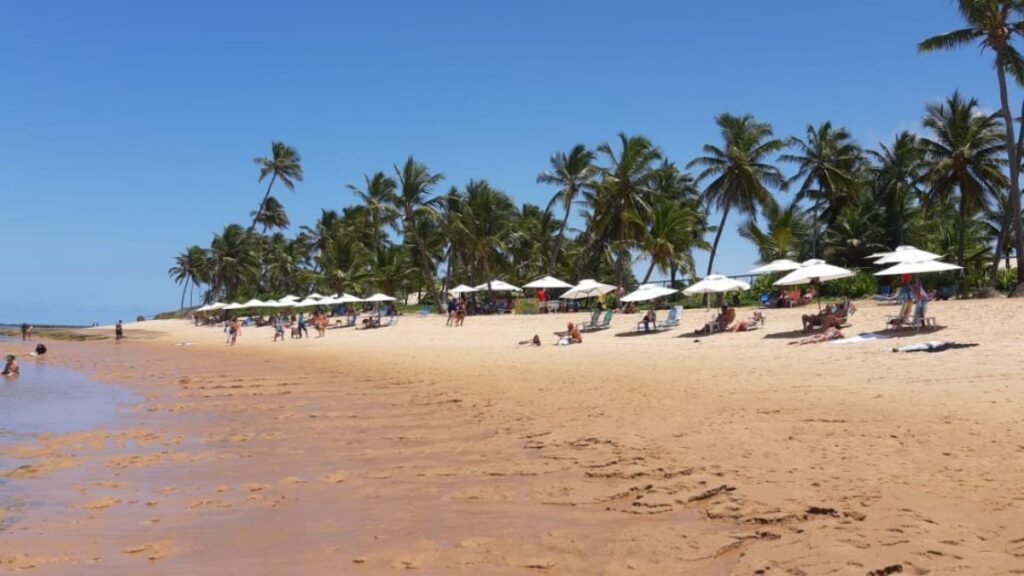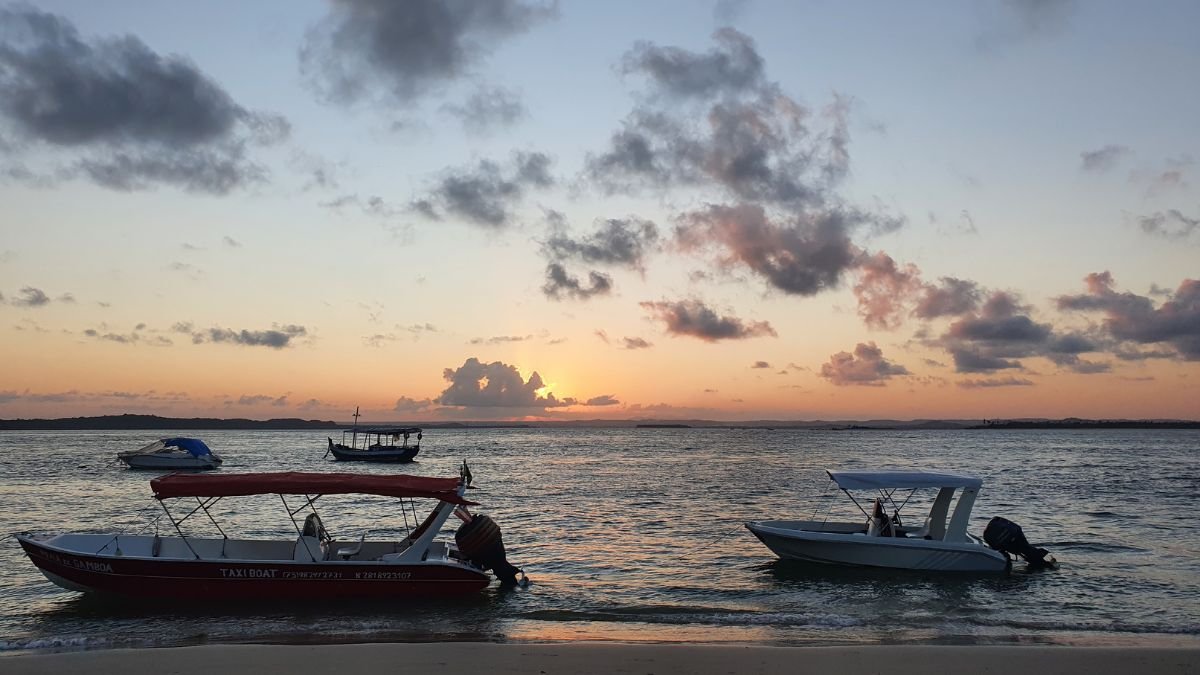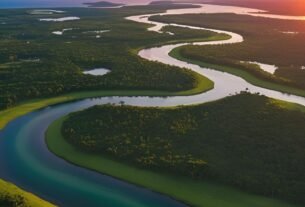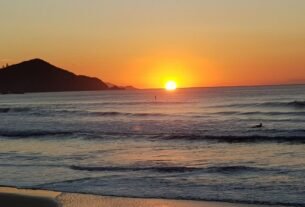Introduction
Have you ever dreamed of escaping to a car-free island with pristine shores and vibrant culture? The stunning Morro de São Paulo offers exactly that—five breathtaking beaches, each with its own charm and distinct atmosphere.
From the tranquil, secluded spots perfect for sunbathing and introspection to the lively, bustling beaches where you can engage in water sports and social activities, there is something for everyone.
Whether you crave adventure or relaxation, this Bahian paradise delivers both, allowing visitors to explore lush landscapes, enjoy local cuisine, and immerse themselves in the rich cultural heritage of the island.

Located off Brazil’s coast, this island is gaining popularity among US travelers. Its golden sands, clear waters, and lively atmosphere make it a top pick for an unforgettable getaway. The best part? You can visit Morro year-round, though certain seasons offer ideal conditions.
From secluded coves to lively shores, each beach promises a unique experience. This guide covers everything—transport, stays, and safety tips—so you can make the most of your time there.
Key Takeaways
- Discover five distinct beaches on a car-free island
- Perfect blend of adventure and relaxation
- Growing favorite for authentic Bahian experiences
- Accessible year-round with ideal visiting seasons
- Practical tips included for hassle-free travel
Why Morro de São Paulo is a Must-Visit Destination in Bahia
Imagine stepping onto an island where cars don’t exist, replaced by the rhythmic sound of wheelbarrows rolling through sandy paths. This car-free paradise offers a rare escape from modern hustle, inviting you to unwind at nature’s pace.
The Unique Charm of a Pedestrian Haven
Goods here move by hand-pulled carts, and luggage arrives via wheelbarrows—a nostalgic touch that preserves the village’s authenticity. The heart of the town, Aureliano Lima Square, buzzes with open-air cafés and artisan stalls, perfect for people-watching.
By night, the square transforms. Live music spills from beachfront bars, and lantern-lit paths lead to impromptu dance floors. As one traveler noted:
“It’s like a festival that never ends, yet mornings still belong to the waves and hammocks.”
Adventure Meets Serenity
Days here balance exploration and relaxation. Hike to a secluded beach at sunrise, then kayak through turquoise waters. By afternoon, the island’s five distinct beaches offer everything from snorkeling reefs to quiet coves—all within a 15-minute walk from the town center.
This harmony of energy and calm makes it a top pick for travelers seeking both thrill and peace. For more on navigating this car-free island, explore our detailed guide.
How to Get to Morro de São Paulo: Your Travel Options
Your journey to the island begins with a choice: speed, comfort, or scenic views? Each route has pros and cons, from choppy boat rides to leisurely bus trips. Here’s how to pick the best fit for your budget and travel style.
Catamaran from Salvador: Fast but Choppy
The quickest option is a 2-hour catamaran ride (83 BRL, approximately $17). Departures from Salvador’s terminal marítimo run twice daily. Pack motion sickness pills—waves can be rough.
Luggage arrives via wheelbarrow at the pier. Pro tip: Book window seats for breezy views.
Semi-Terrestrial Transfer: Scenic and Comfortable
For calmer travel, try Cassi Tourismo’s 4-hour transfer (93 BRL/$19). It includes a bus to Valença and a short boat ride. Perfect for families or those prone to seasickness.
Note: A 15 BRL tourist tax is paid on arrival.
Air Taxi: Quick but Pricey
Short on time? A 20-minute flight from Salvador Airport costs ~400 BRL ($80). Flights land near the village, skipping the pier chaos. Ideal for splurgers or tight schedules.
- Budget pick: Catamaran (watch for waves)
- Best views: Semi-terrestrial’s coastal route
- Luxury option: Air taxi saves hours
Morro de São Paulo: 5 Oceanfront Paradises
Five distinct shorelines define this Bahian paradise, each offering a unique slice of coastal magic. From lively hubs to hidden retreats, here’s how to explore them like a pro.
Primeira Praia (First Beach): Water Sports Hub
Closest to the village, this beach thrills with jet skiing and banana boat rides. Calm mornings are ideal for paddleboarding, while afternoons buzz with volleyball games. Walk here in 5 minutes from the town square.
Segunda Praia (Second Beach): Nightlife and Vibes
By day, sunbathers dot the golden sand. At sunset, beachfront bars erupt with live samba and caipirinha towers. Don’t miss the fire-dancing shows—weekly events draw crowds till dawn.
Terceira Praia (Third Beach): Snorkeling Paradise
A narrow stretch of sand leads to vibrant coral reefs. Rent gear from nearby shacks to spot angelfish and parrotfish. Pro tip: Visit at low tide for the clearest water visibility.
Quarta Praia (Fourth Beach): Serene Escape
Natural tide pools form here, perfect for quiet dips. Pack a picnic—this 20-minute walk from town rewards with solitude. Locals love the hidden gem: a lone coconut tree on the tiny Ilha Caitá.
Quinta Praia (Fifth Beach): Gateway to Gamboa
Seekers of therapeutic clay baths trek here at sunrise. The 30-minute coastal trail passes mangrove forests. Time your return with the tide—some paths flood by midday.
| Beach | Walk Time from Town | Top Activity | Atmosphere |
|---|---|---|---|
| Primeira | 5 min | Jet skiing | Lively, social |
| Segunda | 8 min | Sunset parties | Energetic |
| Terceira | 12 min | Snorkeling | Tranquil |
| Quarta | 20 min | Tide pool dips | Secluded |
| Quinta | 30 min | Clay baths | Adventurous |
For more beach activities and local insights, check our complete island guide.
Where to Stay in Morro de São Paulo: Areas & Accommodations
Sleep steps from the sand or perched above the waves. This car-free island offers three distinct lodging styles, each delivering unique perks. Your choice depends on budget, preferred amenities, and desired proximity to beaches or nightlife.
Budget Pousadas Near the Village
Pousada Passarte offers the best value at $50 per night, just 200 feet from Primeira Praia. These guesthouses often include breakfast and hammock lounges. Opt for upper-floor rooms to catch ocean breezes.
Most budget options cluster around Aureliano Lima Square. You’ll trade some quiet for easy access to bars and transport. Wheelbarrows handle luggage transfers—pack light for easier mobility.
Luxury Resorts with Ocean Views
Hotel Pousada Ilha da Saudade stuns with an infinity pool overlooking Segunda Praia. Rates start at $180 per night during peak season. For panoramic views, Villa Giulia’s hilltop suites offer sunrise vistas over the archipelago.
These properties offer concierge services, including boat tours and dining reservations. Many include private beach access and spa treatments.
Hostels for Backpackers
Che Lagarto Hostel attracts social travelers with its nightly caipirinha hours. Dorm beds start at $15, with lockers and shared kitchens. The communal patio hosts impromptu guitar sessions.
Most hostels sit inland—a 10-minute walk to beaches, but closer to affordable eateries. Look for ones offering free walking tours to hidden coves.
| Type | Price Range | Best For | Booking Tip |
|---|---|---|---|
| Pousadas | $50-$90 | Couples/small groups | Direct booking discounts |
| Resorts | $180-$300 | Luxury seekers | Book 3+ months ahead |
| Hostels | $15-$30 | Solo travelers | Check Hostelworld reviews |
For last-minute deals, compare prices on Booking.com and local hotel websites to find the best rates. Many pousadas offer better rates when contacted directly via WhatsApp.
Best Time to Visit Morro de São Paulo
Timing your Bahian escape can make all the difference between packed shores and peaceful coves. The island thrives year-round, but seasons dramatically shift the experience, from festival chaos to serene retreats.
Peak Season: December to February
Over 20,000 visitors flood the island during these months. Expect:
- Vibrant energy: Carnival parades and New Year’s fireworks light up the beaches
- Higher costs: Accommodations spike 40%—book 6+ months ahead
- Limited service: Ferries and tours sell out fast
Shoulder Season Sweet Spots
March to May offers a perfect balance. Temperatures hover at 86°F with minimal rain. Locals call it the *hidden gem* window—warm waters for snorkeling, half-empty beaches, and lower prices.
August sees a European influx but avoids extreme crowds. Pro tip: Visit mid-week to dodge weekend surges.
Weather and Crowd Strategies
Rainfall peaks in June (7 inches), but storms pass quickly. For solitude:
- Arrive at the beaches before 9 AM or after 4 PM
- Explore Quinta Praia on weekdays—clay baths stay quiet
- Skip Sundays when day-trippers dominate
Many businesses close briefly in April. Check ferry schedules—reduced hours apply in the low season.
Top Activities Beyond the Beaches
While the shorelines dazzle, this Bahian gem offers thrilling adventures and cultural gems to be discovered inland. From soaring above the coast to discovering hidden therapeutic spots, here’s how to elevate your island experience.
Zip-lining from the Lighthouse
Feel the rush on Tiroleza, a 1,640-foot zipline launching from the historic lighthouse. The ride drops you into First Beach’s turquoise waters—pack a waterproof camera for epic aerial shots.
Operators like EcoAdventure provide harnesses and safety briefings. Morning slots avoid wind gusts. Not for the faint-hearted, but worth every second of adrenaline.
Boat Tours to Nearby Islands
Hop on a catamaran to Boipeba Island, where mangrove forests meet deserted beaches. Full-day tours include snorkeling stops and fresh seafood lunches. Local guides point out hidden coves only accessible by small boats.
For a private way to explore, charter a schooner with Bahia Blue. Their sunset cruises feature live reggae and champagne toasts.
Hiking to Gamboa’s Clay Baths
A scenic 40-minute walk along the coast leads to mineral-rich clay pits. Locals swear by their skin-healing properties. The red clay masks detoxify, while the white clay soothes sunburns.
The trail has moderate inclines—wear sturdy sandals. Arrive early to beat the heat and enjoy the baths in solitude.
| Activity | Duration | Best For | Booking Tip |
|---|---|---|---|
| Zipline | 30 min | Thrill-seekers | Book sunrise slots |
| Island Tour | 6-8 hours | Nature lovers | Group discounts available |
| Clay Baths | Half-day | Wellness travelers | Bring a towel |
These things transform a beach holiday into an unforgettable adventure. Whether flying above waves or digging into healing earth, each experience adds depth to your Bahian escape.
Morro de São Paulo’s Nightlife: Where to Party
When the sun dips below the horizon, this Bahian paradise transforms into a pulsating playground. The warm Atlantic breeze carries samba rhythms as lantern-lit paths guide you between beach bars and open-air clubs. Unlike typical resort nightlife, here you’ll dance barefoot in the sand with caipirinhas in hand.
Beachfront Bars and Sunset Parties
Toco do Morcego sets the standard with daily sunset celebrations for just 10 BRL. Their coconut caipirinhas—served in hollowed cocoa fruits—pair perfectly with fire dancers’ twirling performances. As one regular visitor describes:
“It’s like someone bottled Brazilian joy and poured it over ice—every night feels like New Year’s Eve.”
Primeira Praia’s stretch buzzes with competing sound systems after dark. Bar do Souza mixes potent passionfruit cocktails, while Tia Dulce, located further down, offers live forró music on Thursdays. Most restaurants convert into dance spaces by 10 PM—no cover charges, just minimum drink purchases.
Weekly Club Events
Pulsar Club dominates Saturdays with international DJs spinning until sunrise. Their famous “Quadrilha” nights blend electronic beats with traditional Brazilian folk dance moves. For authentic vibes, Wednesday’s “Samba de Roda” at Vilha Guaíba features local percussionists.
Key weekly highlights:
- Sunday: Jazz nights at Pousada Colibri’s rooftop
- Tuesday: Reggae beach party near Segunda Praia
- Friday: Silent disco at Praça Aureliano Lima
Brazilian crowds dominate mid-week, while weekends attract more international visitors. For safety, stick to well-lit paths and use registered wheelbarrow transport after midnight. The party things wind down around 2 AM—early by Brazilian standards, but perfect for beachside recovery the next day.
Local Cuisine: What to Eat and Drink
Dining here is an adventure, blending Afro-Brazilian traditions with fresh coastal ingredients. The island’s food scene mirrors Bahia’s vibrant culture—think coconut milk, dendê oil, and fiery malagueta peppers. Whether you crave street snacks or gourmet feasts, every meal tells a story.

Must-Try Bahian Dishes
Moqueca reigns supreme—a fragrant fish stew slow-cooked in clay pots with tomatoes, cilantro, and dendê oil. For the best version, head to the Portalo restaurant, where they serve it with farofa (toasted cassava flour) and sunset views.
Jony Milanesa’s $2.50 schnitzel sandwiches are a town favorite. Their crispy breaded chicken pairs perfectly with lime wedges and chili sauce. Vegetarians? Try acarajé, deep-fried black-eyed pea fritters stuffed with shrimp paste.
Signature Drinks and Dining Tips
Caipirinhas here get a twist—served in hollowed cocoa fruits at beach bars. The drink’s sweetness balances the chili-laced snacks. For food safety, stick to busy spots with high turnover, like Tia Dulce’s lunch buffet.
Upscale service shines at Vila Gourmet, where chefs fuse Bahian flavors with French techniques. Their tasting menu includes vatapá (shrimp custard) and passionfruit mousse.
| Dining Style | Spot | Must-Order | Price Range |
|---|---|---|---|
| Budget | Jony Milanesa | Schnitzel sandwich | $2–$5 |
| Mid-range | Portalo | Moqueca | $15–$25 |
| Luxury | Vila Gourmet | Tasting menu | $50+ |
Vegan? Seek out restaurant Sabor da Terra for jackfruit tacos. Pro tip: Many places close between 3–6 PM—plan meals around siesta time.
Practical Tips for Your Trip
Smart planning ensures your Bahian adventure is smooth from start to finish. Whether it’s packing the right gear or navigating local payments, these tips will help you make the most of your travel experience.
Packing Like a Pro
Reef-safe sunscreen is a must—local shops charge premium prices. A waterproof phone case protects your device during beach hops and boat rides. Pack light; wheelbarrows transport luggage from the terminal to hotels.
Activity-specific essentials:
- Snorkeling: Quick-dry towel and rash guard
- Hiking: Sturdy sandals and a refillable water bottle
- Nightlife: Small cross-body bag for security
Navigating Currency and Payments
Brazil’s PIX system is widely accepted—link your card before the trip. While cards work at most restaurants, keep 200–300 BRL in cash for small vendors. ATMs near the pier charge high fees; withdraw larger sums at Banco do Brasil in town.
Key phrases for smoother transactions:
- “Aceita cartão?” (Do you accept cards?)
- “Quanto custa?” (How much does it cost?)
Getting Around Efficiently
Wheelbarrow taxis cost ~20 BRL per ride—agree on prices upfront. For late-night returns, book registered services, such as Transol. Walking paths are safe but unlit; carry a mini flashlight after dark.
Pro tip: Ferries to Salvador run at set hours—confirm schedules a day in advance to avoid missing your return.
Safety and Health on the Island
Your well-being is key to enjoying this tropical escape—here’s how to stay safe and healthy. While the island is generally secure, knowing local resources and precautions ensures a smooth time. From medical care to navigating busy beaches, these tips prepare you for any scenario.
Medical Facilities and Emergency Care
A single clinic near the tourist tax office handles basic needs. For time-sensitive care, note their limited hours (8 AM–6 PM daily). The ambulance is a modified golf cart—manage expectations for serious emergencies.
Essential health prep:
- Travel insurance: Verify coverage for evacuation to Salvador
- Things to pack: Hydrocortisone cream for sandfly bites, electrolyte packets
- Common issues: Sunburn and dehydration—reapply SPF 50+ hourly
Navigating Crowds and Risks
Peak day trips bring surges to popular beaches. Avoid Primeira Praia at midday; opt for Quarta Praia’s quieter coves. Keep valuables in waterproof pouches during walks along crowded paths.
Smart strategies:
- Use wheelbarrow service for luggage—prevents theft while settling in
- Store clinic contacts in your phone: +55 11 2345-6789
- Carry cash for taxis after dark
| Emergency Resource | Location | Contact |
|---|---|---|
| Medical Clinic | Near tax office | +55 75 3456-7890 |
| Police | Aureliano Lima Square | 190 |
| Tourist Police | Pier entrance | +55 75 9876-5432 |
Day Trips from Morro de São Paulo
Short excursions reveal Bahia’s rich diversity just a boat ride away. Whether you crave untouched islands or historic towns, these day trips add depth to your coastal escape.
Boipeba Island Adventure
Expresso Madalena’s 150 BRL tour whisks you to Boipeba in 90 minutes. This car-free paradise dazzles with mangrove forests and empty beaches. Local guides point out prime snorkeling spots near coral reefs.
Pack light but smart:
- Essentials: Waterproof bag, reef-safe sunscreen
- Photo ops: Velha Boipeba village’s colorful cottages
- Pro tip: Book private tours for secluded coves
Exploring Valença
A 40-minute bus ride unveils Valença’s 18th-century architecture. The Church of Nossa Senhora do Amparo towers over cobbled streets. Stop at Mercado Municipal for handcrafted lace and cassava sweets.
For seamless logistics:
| Destination | Transport | Duration | Cost |
|---|---|---|---|
| Boipeba | Speedboat | Full day | ~150 BRL |
| Valença | Bus | Half day | 25 BRL |
No passport is required for island hops, but it’s recommended to carry cash for artisanal purchases. These escapes prove that Bahia’s magic extends far beyond the shoreline.
How to Get Around the Island
Navigating this car-free paradise is part of the adventure—sandy paths replace roads, and wheelbarrows become taxis. The entire way system prioritizes pedestrians, with clearly marked trails connecting all key areas. You’ll quickly adapt to the slower pace, where a 20-minute walk becomes a chance to spot tropical birds.

Walking Paths and Trails
Five primary routes fan out from the terminal area near the pier. The easiest is the flat Primeira Praia path (5 minutes), while Quinta Praia’s coastal trail requires sturdy footwear. Difficulty ratings help plan your walk:
- Green routes: Paved to Segunda Praia (8 min) with shade trees
- Blue routes: Sandy trails to Terceira/Quarta (12-20 min)
- Red routes: Rocky inclines to Quinta Praia (30+ min)
Morning hikes beat the heat, with average temperatures of 75°F before 10 AM. One local guide advises:
“Treat the trails like a treadmill—bring water, wear grip shoes, and watch for uneven steps near tide zones.”
Luggage Transport by Wheelbarrow
Because the island is so hilly, it’s important to be aware that there’s a distance to travel from the pier to the hotels and guesthouses. Therefore, your bags will be transported by the famous handcarts, a mode of transportation adapted to the region.
Your bags arrive at your destination in style on luggage carts. Operators charge R$5 to R$10 per trip from the pier to the hotels. Negotiate prices in advance—a tip of R$2 to R$3 ensures careful handling. But remember that small suitcases and backpacks are the best options for Morro de São Paulo.
Key wheelbarrow tips:
| Situation | Price Range | Wait Time |
|---|---|---|
| Pier to village | 5 BRL | Immediate |
| Beachfront hotels | 8-10 BRL | 5-10 min |
| Hilltop resorts | 10 BRL+ | 15 min |
For sunset walks, carry a mini flashlight—lanterns illuminate main paths, but side trails darken quickly. The safest way back after dusk is via registered wheelbarrow services, available until 11 PM.
Budgeting for Your Trip
Your dollars stretch further when you know the island’s cost secrets. Whether you’re a backpacker or luxury seeker, smart planning maximizes every real. This guide breaks down expenses from hammock sleeps to sunset cocktails.
Daily Cost Breakdown
Budget travelers can thrive on $50 a day, while luxury stays start at $200+. Prices shift dramatically between hostels and beachfront villas. Here’s what to expect:
| Category | Budget | Mid-Range | Luxury |
|---|---|---|---|
| Accommodation | $15 (dorm) | $80 (pousada) | $200+ |
| Meals | $12 (street food) | $25 (restaurant) | $50+ |
| Activities | $10 (hiking) | $30 (snorkel tour) | $100 (private boat) |
| Transport | $5 (wheelbarrow) | $15 (water taxi) | $80 (air taxi) |
Local Savings Strategies
Seasoned visitors know these tricks to cut costs without missing out:
- Time meals right: Lunch specials (prato feito) offer full plates for $8 at beach shacks
- Share tours: Split private boat charters with other travelers met at hostels
- Walk everywhere: The island’s compact size makes taxis unnecessary for most
Free experiences abound if you know where to look. Sunrise yoga on Segunda Praia costs nothing, and hiking to the lighthouse is rewarded with panoramic views. As one thrifty traveler notes:
“I saved $300 by booking last-minute pousada deals via WhatsApp and eating where locals line up.”
Peak season (Dec-Feb) spikes prices by 40%. For better deals, visit from March to May when service remains excellent but crowds are thin. Your dream trip doesn’t require breaking the bank—just these insider ways to explore smarter.
Cultural Highlights and History
Beyond sun-soaked beaches, this island harbors centuries of stories in its weathered stones. Two landmarks stand as testaments to its layered past—a crumbling fortress and a luminous chapel. These sites connect modern visitors to the town‘s colonial roots while offering stunning views.
Fortaleza do Tapirandu Ruins
The 17th-century fortress walls overlook First Beach, where WWII shipwrecks still peek through turquoise waters. Preservation teams reinforce the structure annually using traditional lime mortar techniques. Local guides share tales of pirate raids during 45-minute walking tours (30 BRL).
Key preservation things to note:
- Original cannons face seaward, now protected under glass
- No climbing permitted on unstable northern walls
- Morning visits avoid cruise group crowds
Iglesia Nossa Senhora da Luz
Rebuilt in 1848 after storms destroyed the original, this whitewashed chapel glows at sunset. The senhora luz (Lady of Light) statue arrives by boat during September’s Festa da Padroeira. Photography restrictions apply during mass—check posted hours.
| Festival | Date | Highlights |
|---|---|---|
| Festa da Padroeira | Sept 8 | Flower carpets, candlelit procession |
| Semana Santa | March/April | Wooden saints parade |
| Festa Junina | June 24 | Bonfires, quadrilha dancing |
Today, both sites inspire local artists. The fortress is depicted on handmade ceramics sold near the pier, while the chapel’s arches have influenced contemporary resort architecture. As one historian noted:
“These stones hold memories of conquest, faith, and resilience—the true soul of Bahia.”
Eco-Tourism and Nature Experiences
The island’s true magic extends far beyond its famous shorelines. Over 60% of the land remains covered by lush Atlantic rainforest, home to rare species and conservation projects. These untouched areas offer responsible travelers unique ways to connect with nature while supporting preservation efforts.
Exploring the Atlantic Rainforest
Guided hikes reveal hidden waterfalls and endemic wildlife. The 2-mile Trilha do Farol trail winds through protected zones where you might spot:
- Golden-headed lion tamarins (endangered primates)
- Over 120 bird species, including red-billed toucans
- Medicinal plants used by local communities
Essential gear for rainforest adventures:
| Item | Purpose |
|---|---|
| Closed-toe shoes | Protects against roots and insects |
| Biodegradable repellent | Prevents harm to delicate ecosystems |
| Reusable water bottle | Reduces plastic waste |
Protecting Marine Life
From March to September, endangered hawksbill turtles nest on remote northern beaches. Volunteers from Projeto Tamar monitor these sites on a daily basis. Visitors can join guided night walks (with red-filter flashlights) to witness hatchlings making their way to the water.
Key conservation things to remember:
- Maintain a 15-foot distance from nesting areas
- Avoid flash photography near turtles
- Report poaching or disturbance to +55 75 9123-4567
Tidal pools near Quarta Praia form miniature ecosystems. Local biologists lead educational tours explaining how these beach formations support marine biodiversity. For hands-on involvement, contact the Morro de São Paulo Eco-Association about weekly cleanup initiatives.
Conclusion: Planning Your Perfect Morro de São Paulo Getaway
Your Bahian escape deserves careful planning to make the most of every sunlit moment. The best time to visit is when good weather and smaller crowds balance each other—March to May or August to November. Book accommodations early for peak seasons, especially if eyeing beachfront stays.
A 4-5 day trip allows you to explore all five beaches, as well as cultural gems. Split your day between morning adventures and afternoon relaxation. Pack reef-safe sunscreen and waterproof bags—essentials for island hopping.
To visit Morro responsibly, respect marine life, and support local businesses. Share your experiences to help future travelers find their ideal way to enjoy this paradise. Ready to turn these tips into memories? Learn more about Salvador .
FAQ
What are the best beaches to visit in Morro de São Paulo?
The top five beaches include Primeira Praia for water sports, Segunda Praia for nightlife, Terceira Praia for snorkeling, Quarta Praia for tranquility, and Quinta Praia leading to Gamboa.
How do I get to the island from Salvador?
You can take a catamaran for speed, a semi-terrestrial transfer for comfort, or an air taxi for a quick flight.
What’s the best time of year to visit?
The peak season (December–March) offers lively crowds, while the shoulder season (April–June) provides milder weather and lower prices.
Are there activities beyond the beaches?
Yes! Try zip-lining from the lighthouse, boat tours to nearby islands, or hiking to Gamboa’s natural clay baths.
Where should I stay for a budget-friendly trip?
Budget pousadas near the village or hostels are great options, while luxury resorts offer ocean views for higher budgets.
What local dishes should I try?
Don’t miss Bahian moqueca (seafood stew) or caipirinhas served in cocoa fruit for a tropical twist.
Is the island safe for travelers?
Yes, but stay aware in crowds. Medical facilities are limited, so pack essentials like sunscreen and motion sickness meds.
How do I get around without cars?
Walking is the main option—luggage is often transported by wheelbarrow. Trails connect beaches and attractions.
Can I visit nearby islands?
Absolutely! Boipeba Island and Valença are popular day trips with boat tours available.
What’s unique about the island’s culture?
Explore historic sites like Fortaleza do Tapirandu or Iglesia Nossa Senhora da Luz for a glimpse into local heritage.




